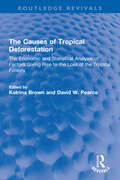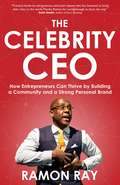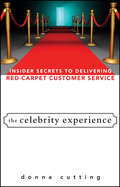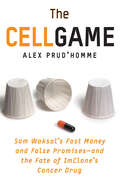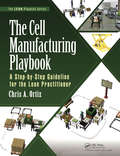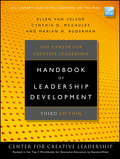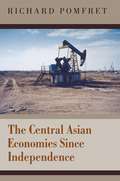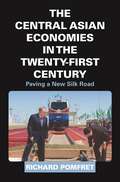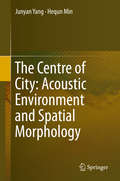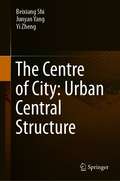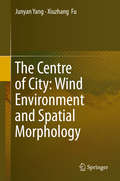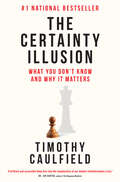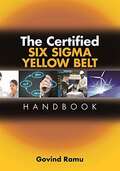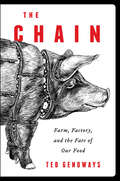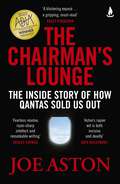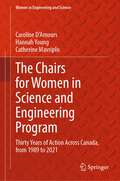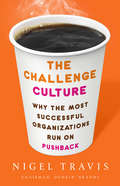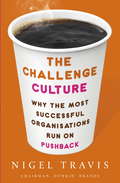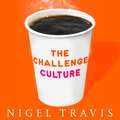- Table View
- List View
The Causes of Tropical Deforestation: The Economic and Statistical Analysis of Factors Giving Rise to the Loss of the Tropical Forests (Routledge Revivals)
by Katrina Brown David W. PearceThe Causes of Tropical Deforestation (1994) is an analysis of the problem of deforestation, using statistical technique – a form of ‘environ-metrics’ – to discover the true causes of an issue whose basis is hotly debated, and attributed to causes as varied as poverty, external debt, multinational logging companies, government corruption, the IMF, population growth, and non-sustainable agriculture.
The Celebrity CEO: How Entrepreneurs Can Thrive by Building a Community and a Strong Personal Brand
by Ramon RayThe Celebrity CEO is the complete guide to creating a strong personal brand. By developing your personal brand, you will set your business apart from your competitors and become known as the expert in your industry. The Celebrity CEO is the complete guide to creating a strong personal brand. By developing your personal brand, you will set your business apart from your competitors and become known as the expert in your industry. Written for entrepreneurs and small business owners who want to make a massive impact and build a loyal fan base, The Celebrity CEO is the source for celebrity status in business. Learn from the founder of Smart Hustle Media, Ramon Ray, the mind-set of a celebrity CEO and the tools to cultivate your tribe.
The Celebrity Experience
by Donna CuttingThe Celebrity Experience combines the best practices of the business world with those of the celebrity world to create a practical and proactive guide for anyone who wants to bring their business's internal and external customer service to the level of star treatment. Based on the unique ways celebrities are treated, the book shares techniques you can use to treat your customers to a red-carpet experience, guaranteeing repeat business and stellar word of mouth.
The Cell Game: Sam Waksal's Fast Money and False Promises—and the Fate of ImClone's Cancer Drug
by Alex Prud'hommeThe “chilling tale” of ImClone Systems, its promising cancer drug, Erbitux, and the insider trading scandal that ensnared Martha Stewart (U.S. News & World Report).The Cell Game is the quintessential business saga of the late 1990s. It's the story of big money and cutting-edge science, celebrity, greed, and slipshod business practices; the story of biotech hype and hope and every kind of excess.At the center of it all stands a single, enigmatic figure named Sam Waksal. A brilliant, mercurial, and desperate-to-be-liked entrepreneur, Waksal was addicted to the trappings of wealth and fame that accrued to a darling of the stock market and the overheated atmosphere of biotech IPOs. At the height of his stardom, Waksal hobnobbed with Martha Stewart in New York and Carl Icahn in the Hamptons, hosted parties at his fabulous art-filled loft, and was a fixture in the gossip columns. He promised that Erbitux would "change oncology," and would soon be making $1 billion a year.But as Waksal partied late into the night, desperate cancer patients languished, waiting for his drug to come to market. When the FDA withheld approval of Erbitux, the charming scientist who had always stayed just one step ahead of bankruptcy panicked and desperately tried to cash in his stock before the bad news hit Wall Street.Waksal served time in prison, the first of the Enron-era white-collar criminals to be sentenced. Yet his cancer drug has proved more durable than his evanescent profits.“A fast-paced, absorbing, and dramatic account . . . An important, excellent book that makes for fascinating reading.” —Library Journal
The Cell Manufacturing Playbook: A Step-by-Step Guideline for the Lean Practitioner (The\lean Playbook Ser.)
by Chris A. OrtizThis book describes how to effectively implement cell manufacturing. It covers the eight Wastes of Lean and the six Lean metrics that are recommended in each implementation and a description of what cell manufacturing is and its application to improving operational processes.
The Center for Creative Leadership
by Srikant M. Datar David A. Garvin Carin-Isabel KnoopThe Center for Creative Leadership (CCL) was founded in 1970 on the notion that leadership was not innate but could be learned. CCL evolved into one of the world's top leadership development organizations, involved in both research and program design and delivery. This case explores CCL's approach to leadership and management education for executives and presents some of the challenges the CCL faces as many different types of leadership development providers continue to emerge.
The Center for Creative Leadership Handbook of Leadership Development
by Cynthia D. Mccauley Ellen Van Velsor Marian N. RudermanPraise for The Center for Creative LeadershipHandbook of Leadership Development"The most authoritative, comprehensive, and practical source for developing leadership capability in any organization. The handbook integrates the very best of theory and practice, and serves as a valuable road map to creating a foundation of systemic leadership excellence, now and for the future."--Thomas J. Griffin, vice president, organizational learning and chief teaching officer, U.S. Cellular"Only from the Center for Creative Leadership could we expect to see such a rich, authoritative, and actionable set of the latest resources for developing leaders. All those who have responsibility for developing leaders (senior executives, leader development professionals, and leaders themselves), as well as those who study leadership, need to read this book."--Douglas T. "Tim" Hall, founding director, Executive Development Roundtable, Boston University"The changes in the third edition of The Handbook of Leadership Development make a good book even better. The authors provide a broad perspective on the most relevant topics for academics and practitioners. The emphasis on development of collective leadership capacity as well as development of individual leaders is consistent with the growing recognition that strategic leadership, shared leadership, and flexible change leadership are essential for sustained organizational effectiveness in a dynamic global economy. The book is a valuable source of knowledge and practical advice for anyone who is responsible for providing or managing leadership development."--Gary Yukl, professor of management, University at Albany-SUNY"We consider leadership to be the single most important factor influencing the performance of our organization. This book is brilliant in defining what we need to do and what capabilities we need to assist our leaders to grow and develop."--Morten Raabe, vice president of Organisation Development, WW ASA, Oslo, NorwayNote: CD-ROM/DVD and other supplementary materials are not included as part of eBook file.
The Center of the World: A Global History of the Persian Gulf from the Stone Age to the Present
by Allen James FromherzThis sweeping history reorients our understanding of the Middle East, placing the Gulf at the heart of globalized trade and cross-cultural encounters. World history began in the Persian Gulf. The ancient port cities that dotted its coastlines created the first global seaboard, a place from where faiths and cultures from around the world set sail and made contact. More than a history, The Center of the World shows us that contradictions that define our modern age have always been present. For over four thousand years, the Gulf—sometimes called the Persian Gulf, sometimes the Arabian Gulf—has been a global crossroads while managing to avoid control by the world’s greatest empires. In its history, we see a world of rapid change, fluctuating centers of trade, a dependency on uncertain global markets, and intense cross-cultural encounters that hold a mirror to the contemporary world. Focusing each chapter on a different port around the Gulf, The Center of the World shows how the people of the Gulf adapted to larger changes in world history, creating a system of free trade, merchant rule, and commerce that continues to define the region today.
The Central Asian Economies Since Independence
by Richard PomfretThe 9/11 attacks, the U.S. invasion of Afghanistan, and the oil boom of recent years have greatly increased the strategic importance of resource-rich Central Asia, making an understanding of its economic--and therefore political--prospects more important than ever. In The Central Asian Economies Since Independence, Richard Pomfret provides a concise and up-to-date analysis of the huge changes undergone by the economies of Kazakhstan, the Kyrgyz Republic, Tajikistan, Turkmenistan, and Uzbekistan since the collapse of the Soviet Union in 1991. The book assesses the economic prospects of each country, and the likelihood that economic conditions will spur major political changes. With independent chapters on each country, and chapters analyzing their comparative economic performance, the book highlights similarities and differences. Facing common problems caused by the breakdown of Soviet economic relations and the hyperinflation of the early 1990s, these countries have taken widely divergent paths in the transition from Soviet central planning to more market-based economies. The book ends in 2005 with the bloodless Kyrgyz revolution and the violence in Uzbekistan, which signaled the end of the region's political continuity. Throughout the book, Pomfret emphasizes the economic forces that foster political instability--from Kazakhstan's resource boom and Turkmenistan's lack of reform to Tajikistan's abject poverty.
The Central Asian Economies in the Twenty-First Century: Paving a New Silk Road
by Richard PomfretThis book analyzes the Central Asian economies of Kazakhstan, the Kyrgyz Republic, Tajikistan, Turkmenistan, and Uzbekistan, from their buffeting by the commodity boom of the early 2000s to its collapse in 2014. Richard Pomfret examines the countries’ relations with external powers and the possibilities for development offered by infrastructure projects as well as rail links between China and Europe.The transition of these nations from centrally planned to market-based economic systems was essentially complete by the early 2000s, when the region experienced a massive increase in world prices for energy and mineral exports. This raised incomes in the main oil and gas exporters, Kazakhstan and Turkmenistan; brought more benefits to the most populous country, Uzbekistan; and left the poorest countries, the Kyrgyz Republic and Tajikistan, dependent on remittances from migrant workers in oil-rich Russia and Kazakhstan. Pomfret considers the enhanced role of the Central Asian nations in the global economy and their varied ties to China, the European Union, Russia, and the United States. With improved infrastructure and connectivity between China and Europe (reflected in regular rail freight services since 2011 and China’s announcement of its Belt and Road Initiative in 2013), relaxation of United Nations sanctions against Iran in 2016, and the change in Uzbekistan’s presidency in late 2016, a window of opportunity appears to have opened for Central Asian countries to achieve more sustainable economic futures.
The Centre of City: Acoustic Environment and Spatial Morphology
by Junyan Yang Hequn MinThe main focus of this monograph is urban acoustic environment of urban spatial morphology.It provides in-depth evaluation and research on the correlation between urban spatial morphology indicator and urban acoustic environment using urban spatial morphology and urban space units. Furthermore, it conducts quantitative analysis and statistic evaluation to reveal the relationship between urban planning indicators and acoustic environment. It also provides optimized strategies from three aspects of urban planning, architecture and landscape respectively. It intertwines the quantitative research of both acoustic environment and urban morphology through in-depth analysis and urban microclimate simulation by using Cadna/A acoustic simulation software. It concludes the influencing mechanism of acoustic environment on urban morphology. It makes a valuable contribution for the research on urban environment and urban morphology.
The Centre of City: Thermal Environment and Spatial Morphology
by Junyan Yang Xing ShiA major objective of this monograph is to identify the impact of thermal environment on urban center district. It provides in-depth evaluation and research on the correlation between urban spatial morphology indicator and urban thermal environment. In addition, the distribution characteristics of thermal environment and urban morphology units sample are also evaluated intensively. Furthermore, it analyses from three aspects of urban planning, architecture and landscape respectively and includes 35 concrete measures that could be brought into practice on reducing negative impact of urban thermal environment. Through 500 vivid figures, graphs and diagrams it illustrates the relationship between urban morphology and urban thermal environment. The analysis software employed by the author includes Ecotect, ENVI-met and Ray-man. It intertwines the quantitative research of both thermal environment and urban morphology through in-depth analysis and urban microclimate simulation. It makes a valuable contribution for the research on urban environment and urban morphology.
The Centre of City: Urban Central Structure
by Yi Zheng Junyan Yang Beixiang ShiThis book presents the latest research results related to urban center and urban center. It expounds the theoretical connotation, development models, hierarchical function, and spatial layout of the urban central structure through over 200 figures and tables. In addition, it analyzes the threshold characteristics, structural hierarchy, spatial characteristics, and development rules of urban central structure through field research and quantitative researches on the major urban central structures in Asia. Meanwhile, how to solve the issue of construction and layout of urban central structure in planning and design practice is also covered. The book reveals the laws and spatial characteristics of urban central structure and provides a valuable guide both for urban designers and planners as well as researchers and students working in urban design and planning fields. It sheds new light on better understanding of the urban central structure.
The Centre of City: Wind Environment and Spatial Morphology
by Junyan Yang Xiuzhang FuThis book focuses on the urban wind environment of urban center district. Through urban spatial morphology and urban space units it provides in-depth evaluation and research on the correlation between urban spatial morphology indicator and urban wind environment. Based on urban spatial morphology indicators, such as building density, FAR, average building height and wind environment parameter, it conducts quantitative analysis and statistic evaluation to acquire the influence relationship between urban planning indicators and wind speed. In addition, based on the 13 typical urban morphology units it also analyses the different situation of wind environment. Finally it provides the optimized strategies on urban planning, architecture and landscape. It intertwines the quantitative research between wind environment and urban morphology through in-depth analysis and urban microclimate simulation. It makes a valuable contribution for the research on urban environment and urban morphology.
The Certainty Illusion: What You Don't Know and Why It Matters
by Timothy CaulfieldIn a world where there is so much conflicting information about how we are supposed to live, what can we really know?Knowing the truth, what&’s real from what&’s fake, should be easy. In today&’s world, that&’s far from the case. In The Certainty Illusion, Timothy Caulfield lifts the curtain on the forces contributing to our information chaos and unpacks why it&’s so difficult—sometimes even for experts—to escape the fake.Whether it&’s science, our own desire to be good and do the right thing, or the stories and opinions of others, there&’s more to sussing out the truth than simply tracking down what feels like an authoritative source. Caulfield argues that these major forces—science, goodness, and opinion—drive beliefs and behaviour, but the ways that they can be corrupted, or worse, used to nefarious ends by bad actors, are endless.While it may feel, at times, as though we are circling the drain of truth, especially as new technologies make it even easier to spread dangerous fictions, Caulfield pulls us out of the vortex and keeps us afloat, helping us recognize and combat the forces that threaten to pull us under.
The Certified Six Sigma Yellow Belt Handbook
by Govindarajan RamuThis reference manual is designed to help both those interested in passing the exam for ASQ s Certified Six Sigma Yellow Belt (CSSYB) and those who want a handy reference to the appropriate materials needed for successful Six Sigma projects. It is intended to be a reference for both beginners in Six Sigma and those who are already knowledgeable about process improvement and variation reduction. The primary layout of the handbook follows the Body of Knowledge (BoK) for the CSSYB released in 2015. The author has utilized feedback from Six Sigma practitioners and knowledge gained through helping others prepare for exams to create a handbook that will be beneficial to anyone seeking to pass not only the CSSYB exam but also other Six Sigma exams. In addition to the primary text, the handbook contains numerous appendixes, a comprehensive list of abbreviations, and a CD-ROM with practice exam questions, recorded webinars, and several useful publications. Each chapter includes essay-type questions to test the comprehension of students using this book at colleges and universities. Six Sigma trainers for organizations may find this additional feature useful, as they want their trainees (staff) to not only pass ASQ s Six Sigma exams but have a comprehensive understanding of the Body of Knowledge that will allow them to support real Six Sigma projects in their roles.
The Chad-Cameroon Petroleum Development and Pipeline Project (E)
by Aldo Sesia Benjamin C. EstySupplement
The Chain: Farm, Factory, and the Fate of Our Food
by Ted GenowaysA powerful and important work of investigative journalism that explores the runaway growth of the American meatpacking industry and its dangerous consequences“A worthy update to Upton Sinclair’s The Jungle and a chilling indicator of how little has changed since that 1906 muckraking classic.” — Mother Jones“I tore through this book. . . . Books like these are important: They track the journey of our thinking about food, adding evidence and offering guidance along the way.” —Wall Street JournalOn the production line in American packing-houses, there is one cardinal rule: the chain never slows. Under pressure to increase supply, the supervisors of meat-processing plants have routinely accelerated the pace of conveyors, leading to inhumane conditions, increased accidents, and food of questionable, often dangerous quality.In The Chain, acclaimed journalist Ted Genoways uses the story of Hormel Foods and its most famous product, Spam—a recession-era staple—to probe the state of the meatpacking industry, from Minnesota to Iowa to Nebraska. Interviewing scores of line workers, union leaders, hog farmers, and local politicians and activists, Genoways reveals an industry pushed to its breaking point—while exposing alarming new trends, from sick or permanently disabled workers to conflict between small towns and immigrant labor. A searching exposé in the tradition of Upton Sinclair, Rachel Carson, and Eric Schlosser, The Chain is a mesmerizing story and an urgent warning about the hidden costs of the food we eat.
The Chaining of Prometheus: Evolution of a Power Structure for Canadian Science
by F. HayesThe development of a national science policy for Canada – and the priorities to be set within any such policy – have been topics of a mounting debate within government and the scientific community. The questions involved are of concern in every country today: Can governments now afford to support laissez-faire 'pure' research to any extent? Or rather, should available resources be allocated to mission-oriented studies determined by government-established national goals? Professor Hayes assesses the limitations and prospects for success of attempts to impose a pattern of planning on Canadian science and critically examines the reports of the Glassco Commission, the examiners for the OECD, the Lamontagne Committee, and the Science Council, as well as of several university-sponsored groups. The power of the Treasury Board and other parts of the control system also receive attention. Most reports on Canadian science policy have been productions of federal agencies. Of the outside opinions, with a few notable exceptions, analyses and proposals about the natural sciences have been put forward by social scientists. The author, a scientist and former senior servant who has had experience in the research and administration of natural science both in the university and government, makes a unique, personal analysis of the attempts in Canada to impose national planning and controls over the historical free enterprise system of scientific research and development.
The Chairman's Lounge: The inside story of how Qantas sold us out
by Joe AstonFrom the must-read journalist on how power, money and influence work in this country, the full story of how one of the nation's favorite brands brought itself to ground.Before Covid, both Qantas and its CEO Alan Joyce were flying high, the darlings of customers, staff and investors. After Covid hit, only money mattered – in particular, the company's share price and extraordinary executive bonuses. Illegally redundant workers, unethical flight credits, abysmal customer service, antique aircraft: these became Qantas' new brand. How did things go so badly wrong? Why were customers at the end of the queue? And how did an increasingly autocratic Joyce constantly get his own way, with the Qantas board and with both Liberal and Labor governments, which handed out over billions in subsidies and protected lucrative flight routes from foreign competition? For the first time, The Chairman's Lounge tells the full story of how one company banked the nation's loyalty and then cashed in on it. In his celebrated Rear Window column for the Australian Financial Review , Joe Aston's reporting of the ethical failings of Qantas spurred the early retirement of its CEO and the resignation of its chairman. With fresh interviews and revelations, written in Aston's trademark swashbuckling style , The Chairman's Lounge is the definitive account of how Qantas was brought to the ground and who did it. It is a parable of our times. 'A masterclass in investigative journalism... A scathing, unflinching takedown of greed, delusion and a shameless abuse of power, both jaw-dropping and brilliantly incisive' Adele Ferguson
The Chairman: John J. McCloy, The Making of the American Establishment
by Kai BirdAnalysis of the Financial decisions of the United States in the mid-1900's.
The Chairs for Women in Science and Engineering Program: Thirty Years of Action Across Canada, from 1989 to 2021 (Women in Engineering and Science)
by Caroline D'Amours Hannah Young Catherine MavriplisThis book describes the origins and evolution of Canada’s 30-year Natural Sciences and Engineering Research Council Chairs for Women in Science and Engineering Program. The book starts literally with a bang, right as Montreal and all of Canada were rocked by the 1989 Ecole Polytechnique Massacre of 14 women, describing how the Chair program took on a frenetic pace as a single Chairholder, Monique Frize, tried to respond to an entire country’s concerns about women in engineering, both as students and as professionals. The authors first cover the program from 1989 through 1997, when the program was expanded to five regional Chairs, of which there have been over three generations by now. The book then provides synopses of each Chairholder’s comprehensive regional program to recruit, retain and advance girls and women in STEM, organized by generation, providing a unique historical view of the changing landscape for research and outreach programs to increase the participation of women inmale-dominated scientific fields. Readers will find an effective model for national programs addressing equity, diversity, and inclusion in STEM and be inspired by the 16 strong role models who pioneered blended careers in STEM and gender equity advocacy.
The Challenge Culture: Why the Most Successful Organizations Run on Pushback
by Nigel TravisThe executive chairman and former CEO of Dunkin' Donuts and Baskin Robbins reflects on the unique, results-oriented discipline he's developed over decades of leadership, which provides a blueprint for any organization to achieve prosperity.We live in an era in which successful organizations can fail in a flash. But they can cope with change and thrive by creating a culture that supports positive pushback: questioning everything without disrespecting anyone.Nigel Travis has forty years of experience as a leader in large and successful organizations, as well as those facing existential crisis-such as Blockbuster as it dawdled in the face of the Netflix challenge. In his ten years as CEO and chairman of Dunkin' Brands, Travis fine-tuned his ideas about the challenge culture and perfected the practices required to build it. He argues that the best way for organizations to succeed in today's environment is to embrace challenge and encourage pushback. Everyone-from the new recruit to the senior leader-must be given the freedom to speak up and question the status quo, must learn how to talk in a civil way about difficult issues, and should be encouraged to debate strategies and tactics-although always in the spirit of shared purpose. How else will new ideas emerge? How else can organizations steadily improve?Through colorful storytelling, with many examples from his own career-including his leadership in turning around the fear-ridden culture of the London-based Leyton Orient Football Club, of which he is part owner-Travis shows how to establish a culture that welcomes challenge, achieves exceptional results, and ensures a prosperous future.
The Challenge Culture: Why the Most Successful Organizations Run on Pushback
by Nigel Travis'The Challenge Culture is a must-read for employers and employees alike, and promises to get ideas for long-term success percolating.' - Robert Kraft, chairman and CEO of the Kraft Group'Nigel's career, vision and humanity are very refreshing' - Claude Littner, former Chief Executive of Tottenham Hotspur and author of Single-Minded: My Life in BusinessChallenge is essential for survival and sustained success in today's volatile world.We live in an era when successful organisations can fail in a flash. But they can cope with change and thrive by creating a culture that supports positive pushback: questioning everything without disrespecting anyone.Nigel Travis has forty years of experience as a leader in large and successful organizations, as well as those facing existential crisis - such as Blockbuster as it dawdled in the face of the Netflix challenge. In his ten years as CEO and Chairman of Dunkin' Brands, Travis fine-tuned his ideas about the challenge culture and perfected the practices required to build it. He argues that the best way for organisations to succeed in today's environment is to embrace challenge and encourage pushback, rather than reject them. Everyone - from the newest recruit to the senior leader - must be given the freedom to speak up and question the status quo, must learn how talk in a civil way about difficult issues, and should be encouraged to debate strategies and tactics - although always in the spirit of shared purpose. How else will new ideas emerge? How else can organisations steadily improve?Through colourful story-telling, with many examples from his own experiences - including his leadership in turning around the fear-ridden culture of Leyton Orient Football Club -Travis shows how to establish a culture that embraces challenge, achieves exceptional results, and ensures a prosperous future.PRAISE FOR THE CHALLENGE CULTURE:'Nigel Travis has hit the nail on the head. Collective brilliance can only come from challenge and he proves this throughout his own leadership journey. Entertaining, edifying and exactly right.' -- Manley Hopkinson FRSA FRGS, author of Compassionate LeadershipWomen, especially young women, in today's world need to understand the importance of challenging authority and speaking up to share their point of view. The Challenge Culture brilliantly explains how to do it. (Nicole Lapin, author of Boss Bitch and Rich Bitch)'A must read for all people leading organizations in these turbulent times!' (Larry Bossidy, former chairman and CEO of Honeywell International, coauthor of Execution: The Discipline of Getting Things Done)'This book not only takes you inside [Nigel's] businesses, but inside the mind that challenged them to thrive. If you can use 20% of what he's suggesting, you'll be ahead of the game. Use 40% and you can blow the doors off.' (Mark Goldstein, former chief marketing officer of BBDO Worldwide)'Dissent is not disloyalty but can be the spark for innovation and the safeguard for integrity. ... Conformity kills creativity and subverts justice and The Challenge Culture is the antidote to a contagion of conformity across sectors.' (Jeffrey A. Sonnenfeld, Lester Crown Professor of Leadership Practice, Yale School of Management)
The Challenge Culture: Why the Most Successful Organizations Run on Pushback
by Nigel Travis'The Challenge Culture is a must-read for employers and employees alike, and promises to get ideas for long-term success percolating.' - Robert Kraft, chairman and CEO of the Kraft Group'Nigel's career, vision and humanity are very refreshing' - Claude Littner, former Chief Executive of Tottenham Hotspur and author of Single-Minded: My Life in BusinessChallenge is essential for survival and sustained success in today's volatile world.We live in an era when successful organisations can fail in a flash. But they can cope with change and thrive by creating a culture that supports positive pushback: questioning everything without disrespecting anyone.Nigel Travis has forty years of experience as a leader in large and successful organizations, as well as those facing existential crisis - such as Blockbuster as it dawdled in the face of the Netflix challenge. In his ten years as CEO and Chairman of Dunkin' Brands, Travis fine-tuned his ideas about the challenge culture and perfected the practices required to build it. He argues that the best way for organisations to succeed in today's environment is to embrace challenge and encourage pushback, rather than reject them. Everyone - from the newest recruit to the senior leader - must be given the freedom to speak up and question the status quo, must learn how talk in a civil way about difficult issues, and should be encouraged to debate strategies and tactics - although always in the spirit of shared purpose. How else will new ideas emerge? How else can organisations steadily improve?Through colourful story-telling, with many examples from his own experiences - including his leadership in turning around the fear-ridden culture of Leyton Orient Football Club -Travis shows how to establish a culture that embraces challenge, achieves exceptional results, and ensures a prosperous future.PRAISE FOR THE CHALLENGE CULTURE:'Nigel Travis has hit the nail on the head. Collective brilliance can only come from challenge and he proves this throughout his own leadership journey. Entertaining, edifying and exactly right.' -- Manley Hopkinson FRSA FRGS, author of Compassionate LeadershipWomen, especially young women, in today's world need to understand the importance of challenging authority and speaking up to share their point of view. The Challenge Culture brilliantly explains how to do it. (Nicole Lapin, author of Boss Bitch and Rich Bitch)'A must read for all people leading organizations in these turbulent times!' (Larry Bossidy, former chairman and CEO of Honeywell International, coauthor of Execution: The Discipline of Getting Things Done)'This book not only takes you inside [Nigel's] businesses, but inside the mind that challenged them to thrive. If you can use 20% of what he's suggesting, you'll be ahead of the game. Use 40% and you can blow the doors off.' (Mark Goldstein, former chief marketing officer of BBDO Worldwide)'Dissent is not disloyalty but can be the spark for innovation and the safeguard for integrity. ... Conformity kills creativity and subverts justice and The Challenge Culture is the antidote to a contagion of conformity across sectors.' (Jeffrey A. Sonnenfeld, Lester Crown Professor of Leadership Practice, Yale School of Management)
